
23.风
解落三秋叶,能开二月花。
过江千尺浪,入竹万竿斜。
中文解读
李峤(公元644—714年),初唐诗人,字巨山。赵州赞皇(今属河北)人。李峤对唐代律诗和歌行的发展有一定的作用与影响。他前与王勃、杨炯相接,又和杜审言、崔融、苏味道并称“文章四友”。
李峤写的这首描写风的小诗,它是从动态上对风的一种诠释和理解。风是神奇的,千变万化,风是柔弱的,又是强悍的。千姿百态的风,既是人类的朋友,也能给人类带来无尽的灾难,风,让人不得不爱,也让人惧之三分。
白话译文
能吹落秋天的落叶,能催开春天的鲜花。
刮过江面能掀起千尺巨浪,吹进竹林能使万竿倾斜。
英译一
The Wind
Translated by Zhu Manhua
Release three-autumn leaves from the trees,
Have the second month's flowers in bloom.
Cross rivers to urge 1,000-feet high billows,
Incline bamboo forest's 10,000s of bamboo.
(release v.释放 billow n.巨浪 incline v.使倾斜)
英译二
Wind
Translated by Anonymous
It causes autumn leaves to fall,
And spring flowers to blossom.
Passing rivers a thousand feet waves to rise,
Going through the bamboos a myriad stems would bow.
(myriad n.无数)
英译三
Wind
Translated by Wan Feng
Take down late autumn leaves,
Unfold early spring blooms.
Whish rivers into heaves,
And slant thousands of bamboos.
(whish v.呼呼作响 heave n.起伏 slant v.使……倾斜)
英译欣赏
Wind is hard to describe into poetic language, but this poem gives a vivid and unique annotation of wind, which can also be considered as a Chinese puzzle.
这首诗里“解、开、过、入、斜”几个动词,用法妙不可言,英译很难。如果能译出神韵,则堪称佳作。这首诗的英译不多见,这里所选是比较好的。
英译一是首都经济贸易大学朱曼华教授的翻译,采用直译法,意义表达到位,属于精雕细琢之作。用release 翻译“解”, have. . . in bloom 对应“能开”, cross 翻译“过”, incline 对应“入、斜”,是众多译文中最切近原意的翻译。
英译二选自网上,译者信息不详,其用It causes. . . to fall, to bloom,表示“解落”和“能开”,有创意,也非常接近原诗。
Passing rivers a thousand feet waves to rise相当于When it passes rivers, a thousand feet waves will rise。
“入竹万竿斜”译为Going through the bamboos a myriad stems would bow也比较生动传神。
英译三是网友晚枫的翻译,分别用take down、whish. . . into、heave、slant四个动词来对译“解、过、入、斜”几个动词,贴切到位,且翻译用词较少,整个译文显得简洁通俗易懂。
但用Unfold early spring blooms来翻译“能开二月花”略显生硬且不准确,因为unfold指展开、打开、展现物品,没有准确表达“能开花”的意思。这可算是“风”独特的文字魅力。
思考
“能开二月花”,英文中有什么词能更好地用来翻译“开”?